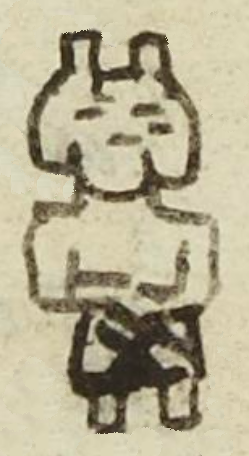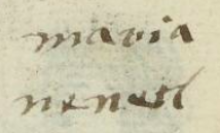Nenetl (MH632r)
This black-line drawing of the simplex glyph for the personal name Nenetl ("Doll") shows a figurine that wears a skirt. It has squared-off protrusions on the top of its head and wide, saggy cheeks on its face.
Stephanie Wood
The vast majority of glyphs or glyphic elements that include the ne- or nen- syllable as a phonogram, typically expressing a negative such as idleness or low productivity, will show figurines in a frontal view. The figurines can be either full bodied, just the bust, or just the head. The syllable comes from the term nenetl, which, as translated by Alonso de Molina, means doll, deity image, or woman’s genitals. These are three very different meanings, although a doll and a figurine of a divine force/deity could have a similar look (see the glyph for Xochiteotl, below). The glyphic representations for nenetl almost always show such figurines, although it can be difficult to tell if they represent dolls or deities. To my knowledge, Alfonso Lacadena (2008a, 21) was the first to publish the interpretation of the nenetl glyph as the phonetic syllable "ne-", which in my experience is more typically nen- and which is more likely to have negative implications.
Keiko Yoneida writes about the negative reading of nenetl “fetiches” as “useless” or “in vain,” which she suggests is a patriarchal deprecation of women. See her discussion of nenetl and the nemontemi days in the calendar in her study, Los Mapas de Cuauhtinchan y la historia cartográfica prehispánica (1991), 140. A few nenetl glyphs or elements in this digital collection do not intend the negative nen-, although most do, and most are female, but a few are male or genderless.
One of the diagnostics for nenetl involves squared-off protrusions on the top of the head. If these are not protrusions such as are found in the glyphs for Cuauhtecolotl or Xolotl (below), perhaps they are vague representations of the hairstyle called neaxtlahualli, where the Nahua woman wears locks of hair twisted up into two points over each side of her forehead. Fortunately, figurines with squared-off protrusions on their heads have survived from pre-contact times. The Museo Tomás Medina Villarruel in Tlahuac, CDMX, has a number of them. These figurines are mostly female, with skirts and distinguishable breasts, and they are often shown in activities such as carrying children or grinding maize. Two images from that collection appear below. These figurines may well be dolls rather than deities.
Ian Mursell has published a photo of such a figurine in an article he shares about rattle figurines. In the image in Mexicolore, the figure on the left fits the nenetl characteristics with its protrusions on its head, and since it is a rattle one could call it a female doll. Other small figurines of women are published in the Museo de Sitio de Tlatelolco (2012, 235); they vaguely resemble dolls and they have interesting headdresses. In that same book, on p. 236, one sees "figurillas femeninas tipo galleta," which are something like dolls that could also be deity sculptures. Again, here, the protrusions of hair at the top of the head more closely resemble the nenetl protrusions.
The five extra days in the calendar of 360 days (xiuhpohualli) were called nemontemi (useless days). It was unlucky to be born on these days. A man who was born in this period was called nenoquich and a woman was called nencihuatl. This is explained in the Florentine Codex in Book 2, folio 12 recto (see: https://florentinecodex.getty.edu/book/2/folio/12r). These individuals were considered unlucky, ill-fated, and even useless. A great many individuals in the Matrícula de Huexotzinco have names beginning with the negative syllable Nen-. Perhaps they were born in that ill-fated period, or perhaps the negative syllable came to be even more liberally applied. With men, for instance, Nentequitl (perhaps a lazy worker) was much more common than Nenoquich. When presented visually, the nen- syllable could derive from nenetl (a figure or sculpture of a deity or a doll). Nenetl also had an association with women’s genitals, which has caused much speculation about a negativity associated with women and their sex, but that might have come from European religious influence. In the colonial context, such concepts and perceptions could easily become muddied.
Stephanie Wood
maria
nenetl
María Nenetl
Stephanie Wood
1560
Jeff Haskett-Wood
toys, muñecas, woman, women, mujeres, skirt, falda, nombres de mujeres, nenetl
Photo credit: Eduardo Flores. Museo Tomás Medina Villarruel, Tlahuac, CDMX.

nene(tl), doll, deity image, or woman's genitals, https://nahuatl.wired-humanities.org/content/nenetl
Muñeca
Stephanie Wood
Matrícula de Huexotzinco, folio 632r, World Digital Library, https://www.loc.gov/resource/gdcwdl.wdl_15282/?sp=346st=image.
This manuscript is hosted by the Library of Congress and the World Digital Library; used here with the Creative Commons, “Attribution-NonCommercial-ShareAlike 3.0 License” (CC-BY-NC-SAq 3.0).
















